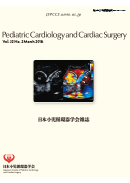Volume 32, Issue 2
Displaying 1-16 of 16 articles from this issue
- |<
- <
- 1
- >
- >|
Preface
-
2016Volume 32Issue 2 Pages 67-68
Published: March 01, 2016
Released on J-STAGE: May 18, 2016
Download PDF (117K)
The 12th Educational Seminar of Japanese Society of Pediatric Cardiology and Cardiac Surgery
-
2016Volume 32Issue 2 Pages 69
Published: March 01, 2016
Released on J-STAGE: May 18, 2016
Download PDF (94K)
Reviews
-
2016Volume 32Issue 2 Pages 70-77
Published: March 01, 2016
Released on J-STAGE: May 18, 2016
Download PDF (4410K) -
2016Volume 32Issue 2 Pages 78-86
Published: March 01, 2016
Released on J-STAGE: May 18, 2016
Download PDF (6031K) -
2016Volume 32Issue 2 Pages 87-94
Published: March 01, 2016
Released on J-STAGE: May 18, 2016
Download PDF (15382K) -
2016Volume 32Issue 2 Pages 95-113
Published: March 01, 2016
Released on J-STAGE: May 18, 2016
Download PDF (12586K) -
2016Volume 32Issue 2 Pages 114-121
Published: March 01, 2016
Released on J-STAGE: May 18, 2016
Download PDF (5224K) -
2016Volume 32Issue 2 Pages 122-128
Published: March 01, 2016
Released on J-STAGE: May 18, 2016
Download PDF (1116K)
Reviews
-
2016Volume 32Issue 2 Pages 129-140
Published: March 01, 2016
Released on J-STAGE: May 18, 2016
Download PDF (4766K) -
2016Volume 32Issue 2 Pages 141-153
Published: March 01, 2016
Released on J-STAGE: May 18, 2016
Download PDF (2841K)
Originals
-
2016Volume 32Issue 2 Pages 154-159
Published: March 01, 2016
Released on J-STAGE: May 18, 2016
Download PDF (1345K) -
2016Volume 32Issue 2 Pages 160-167
Published: March 01, 2016
Released on J-STAGE: May 18, 2016
Download PDF (293K)
Case Reports
-
2016Volume 32Issue 2 Pages 171-178
Published: March 01, 2016
Released on J-STAGE: May 18, 2016
Download PDF (6605K) -
2016Volume 32Issue 2 Pages 181-186
Published: March 01, 2016
Released on J-STAGE: May 18, 2016
Download PDF (4029K)
Editorial Comments
-
2016Volume 32Issue 2 Pages 168-170
Published: March 01, 2016
Released on J-STAGE: May 18, 2016
Download PDF (357K) -
2016Volume 32Issue 2 Pages 179-180
Published: March 01, 2016
Released on J-STAGE: May 18, 2016
Download PDF (153K)
- |<
- <
- 1
- >
- >|
